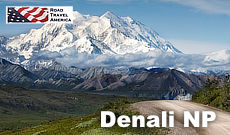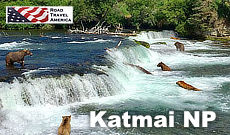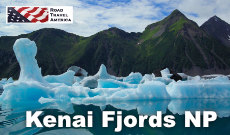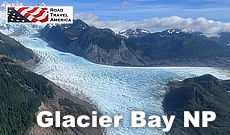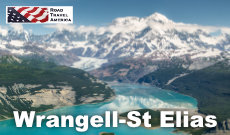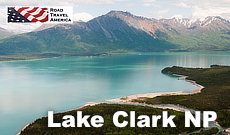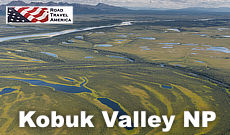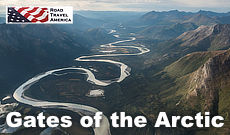
Alaska National Parks 2026 Travel Guide
The United States has the good fortune of having an excellent national parks system, dating back over a hundred years. The National Park Service (NPS), with the help of volunteers and park partners, protect nearly 400 places for 331 million visitors every year. Many visitors to Alaska arrive by cruise ship, most from Seattle, Washington or Vancouver, British Columbia. Read more at our Alaska Cruise Ship Travel Guide 2026
By area, Alaska holds more than half of America's national park lands. With 17 national park units and 16 national wildlife refuges, the options for visits and vacations are plentiful.
On this website we have included an assortment of photographs, maps, commentary, lodging suggestions, and reviews of the national parks in Alaska.
Overview of the Eight National Parks in Alaska
Alaska is home to eight outstanding national parks. The four most-visited national parks are the ones most accessible from the road system or on a cruise. They have convenient accommodations nearby and well-developed tours that make exploring easier for the casual visitor. Four other parks are more remote, and require air or boat access.
Most Accessible
- Denali National Park and Preserve - accessible via train from Fairbanks or Anchorage
- Kenai Fjords National Park - south of Anchorage, access via automobile or train
- Glacier Bay National Park and Preserve - access via cruise ship, or fly or ferry to Gustavus
- Wrangell-St. Elias National Park and Preserve - 7 hour drive from Anchorage or a 9 hour drive from Fairbanks
More Remote Parks
- Katmai National Park and Preserve - Float plane from Homer or Anchorage
- Kobuk Valley National Park - air flight from Kotzebue or Bettles
- Gates of the Artic National Park & Preserve - 1.5 hour air flight from Fairbanks
- Lake Clark National Park & Preserve - Float plane from Homer or Anchorage
Map of National Parks in Alaska
| Map showing the locations of the eight national parks and preserves in Alaska |
 |
Highlights of the National Parks in Alaska
Denali National Park & PreserveDenali National Park and Preserve is located in the interior area of the State of Alaska. The park and contiguous preserve encompass 6,045,153 acres (9,446 sq mi). It was previously known as as Mount McKinley National Park. The park is centered on Denali, the highest mountain in North America, with a summit elevation of 20,310 feet (6,190 m) above sea level. Denali is the third most prominent and third most isolated peak on Earth, after Mount Everest and Aconcagua. Denali's landscape is a mix of forest at the lowest elevations, including deciduous taiga, with tundra at middle elevations, and glaciers, snow, and bare rock at the highest elevations. Glaciers cover one million acres of Denali -- that's one-sixth of the park. Glaciers flow away from mountains, and flow from as high as 19,000 feet above sea level. The Kahiltna glacier is the longest glacier not only in the park, but in the entire Alaska Range. It spans 44 miles down the southwestern side of Denali. |
|
Katmai National Park & PreserveKatmai National Park is located approximately 260 miles southwest of Anchorage, Alaska, and is a true wilderness destination. It is notable for its volcanoes, lakes, Brooks River, the Valley of Ten Thousand Smokes and for its brown bears. The park and preserve encompass 4,093,077 acres (6,395 sq miles). The park is named after Mount Katmai, its centerpiece stratovolcano. The park is located on the Alaska Peninsula, across from Kodiak Island, with headquarters in nearby King Salmon. The area was first designated a national monument in 1918 to protect the area around the major 1912 volcanic eruption of Novarupta, which formed the Valley of Ten Thousand Smokes, a 40-square-mile, 100-to-700-foot-deep pyroclastic flow. The park includes as many as 18 individual volcanoes, seven of which have been active since 1900. |
|
Kenai Fjords National ParkKenai Fjords National Park is located just outside the town of Seward in south-central Alaska, 126 miles south of Anchorage. It covers an area of 669,984 acres (1,046.9 sq mi). It is only one of three national parks in Alaska that can be reached by road. Kenai Fjords National Park was formed in 1980, and named after its many fjords. These are long, narrow valleys with steep cliffsides usually below sea level created by the glaciers flowing through the 936-square-mile Harding Icefield. It is one of only four remaining icefields in U.S., and is also the largest icefield entirely within U.S. borders. In addition to the Harding Icefield, the park also features two other main areas, the Exit Glacier and the coast. Exit Glacier, a half-mile wide river of ice, is the easiest section of the park to access. The park’s rugged coastline includes beautiful tidewater glaciers and abundant marine wildlife. |
|
Glacier Bay National Park & PreserveThe area was designated a national monument in 1925, and Glacier Bay National Park & Preserve was formed in 1980. Located in southeast Alaska west of Juneau, the park covers 3,284,500 acres, or 5,220 square miles. The park and preserve occupy the northernmost section of the southeastern Alaska coastline, between the Gulf of Alaska and Canada. The Canada-US border approaches to within 15 miles (24 km) of the ocean. The highest peak is Mount Fairweather, at 15,308 feet above sea level. |
|
Wrangell-St. Elias National Park & PreserveThe Wrangell-St. Elias National Park and Preserve is located in south central Alaska, and is the largest area managed by the National Park Service (NPS), with a total of 13,175,799 acres (20,587sqmi). The park is the same size as Yellowstone National Park, Yosemite National Park, and Switzerland combined! Designated as a national park in 1980, Wrangell-St. Elias abuts against Canada's Kluane National Park, and together their 20 million acres represent one of the largest wilderness areas left in the world. For this reason, the two parks were recognized by the United Nations as a World Heritage site in 1979. |
|
Lake Clark National Park & PreserveLake Clark National Park & Preserve is located in southwest Alaska, about 100 miles southwest of Anchorage. Created in 1980, the park consists of over 4 million acres making it twice the size of Yellowstone National Park and larger than the state of Connecticut. The 5,625-sq-mile park stretches from the shores of Cook Inlet, across the Chigmit Mountains, to the tundra-covered hills of the western interior. No roads lead to the park which can only be reached by boat or small aircraft, typically floatplanes. The major settled area in the park and preserve is Port Alsworth on Lake Clark. The park holds some of Alaska's finest scenery; an awesome array of mountains, glaciers, granite spires, thundering waterfalls, waved-washed coastline and the largest lake in the state. |
|
Kobuk Valley National ParkKobuk Valley National Park is open year around. The headquarters office and visitor center are located at the Northwest Arctic Heritage Center in the bush village of Kotzebue, Alaska. There are no developed facilities in Kobuk Valley National Park, but 1,795,280 acres of remote backcountry provide endless options for outdoor adventures. In summer, boating, camping, hiking, backpacking, flightseeing, wildlife watching, photography and fishing opportunities abound. For people with Arctic winter survival skills and personal equipment, snow machining, skiing and dog mushing are also possible. Permits are not required for independent travelers. Organized recreational groups do need to get a permit from the Chief Ranger. Winter access is by plane, snowmachine or dogs. Plan to fly into the park, unless you have your own snowmachine or dogteam. Skiing, snowshoeing, dogsledding or skijoring through the mountains or on the frozen rivers are all possible adventures. Read more about Kobuk Valley National Park at NPS |
|
Gates of the Arctic National Park & PreserveGates of the Arctic National Park and Preserve, one of the finest wilderness areas in the world, straddles the Arctic Divide in the Brooks Range, America's northernmost chain of mountains. Second only to Wrangell-St. Elias National Park in size, Gates of the Arctic covers 13,238 square miles, sprawls 800 miles from east to west and is entirely north of the Arctic Circle. It extends from the southern foothills of the Brooks Range, across the range's ragged peaks and down onto the North Slope. With the exception of the Dalton Highway, the park is far from any roads and is home to only one village, Anaktuvuk Pass. Eight more Native villages dot the perimeter but all have less than 400 permanent residents. In the simplest terms, Gates of the Arctic is a vast wilderness the size as Switzerland that contains no National Park Service facilities, visitor centers or campgrounds. Gates of the Arctic is a wilderness park, with no roads or trails into the park lands, so visitors must fly or hike into the park. Access to the park begins in Fairbanks, Alaska, with several small airlines that provide daily flights into the gateway communities of Bettles and Anaktuvuk Pass and flag stops to Coldfoot. Read more about Gates of the Arctic National Park & Preserve at NPS |
List of Other NPS Parks and Preserves in Alaska
More Popular Alaska Travel Destinations |
|||
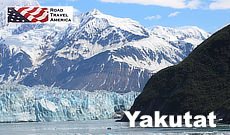 |
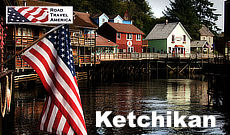 |
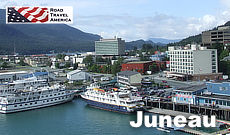 |
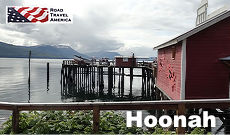 |
 |
|||
